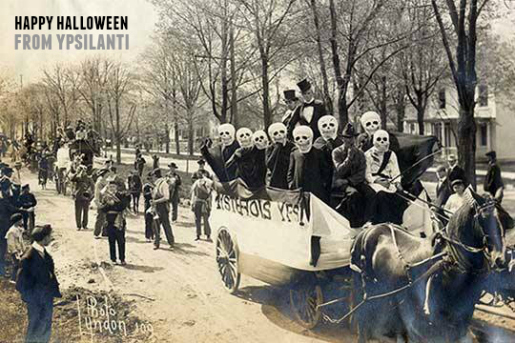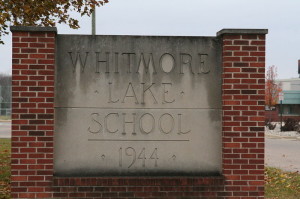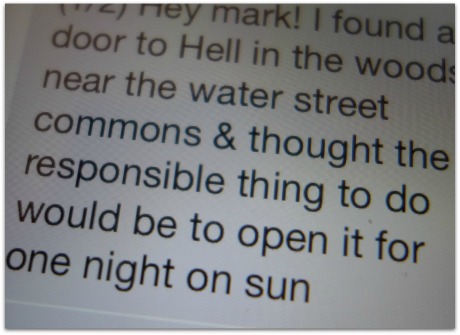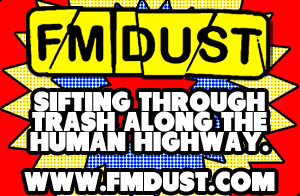Still trying to unravel the mystery of why people would choose, of their own free will, to move to Ypsilanti, I reached out to new residents Isaac and Emily Wingfield, and demanded that they submit to a formal Ypsilanti Immigration Interview. Here are the results.
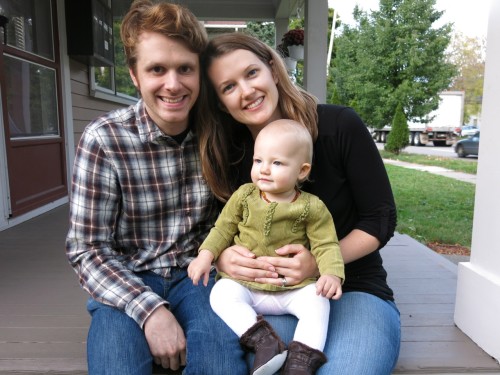
MARK: Isaac, I understand that you just recently took a position at the University of Michigan and decided to settle down in Ypsilanti. Why Ypsi? Was it strictly a financial decision, or did other things factor into it?
ISAAC: On paper it was largely a financial decision… researching places to live from 350 miles away, we didn’t have a lot to go on. There were other things that definitely factored in as well, like good public transportation and being reasonably bicycle friendly. (Since I’m either biking or riding the bus to work, these were both essential.) That said, when we visited to look at our options, we really liked that Ypsi felt like its own place. I was also drawn to the touch of grittiness Ypsi has.
MARK: It’s a discussion we have here quite a bit. There are some in Ypsi, I think, who would see a downtown Starbucks, for instance, as a good thing… a sign that we’d somehow made it as a community. I’m in the other camp. I think, in the long run, authenticity is more important. In a world where everything is beginning to look the same, I value places that are able to maintain their unique identities, and I suspect that those of us who feel this way are growing in number. Fortunately, we haven’t really had to have that fight here yet, as Ypsi isn’t exactly on the radar of corporate America, but I suspect that it’ll happen. Hopefully, by the time it does, we’ll have learned a lesson or two from our neighbor to the west, where chains making more significant inroads.
EMILY: I don’t want a Starbucks…
ISAAC: I’d agree. I think having more independent places gives you a much more intimate sense of place than somewhere like Starbucks, which are the same everywhere in the country.
EMILY: But, we need people to start and run businesses. Do you think Ypsilanti has entrepreneurs like that?
MARK: We’ve got a few, but we could always use more. My hope is that, with the success of places like the Corner Brewery, Beezy’s and the Wurst Bar, that others begin to realize that there’s real opportunity here. I suspect that food and beer is where it will start, but one hopes that it expands from there. We have the Rocket, which is great, but I’d like to see other retail businesses open. And, ultimately, I’d like to see us bringing in a few tech companies from Ann Arbor, the employees of which, I suspect, would rather be in a real downtown environment than in an office park a few miles from a shopping mall. But, yeah, I think we can do it.
ISAAC: Yeah, that sounds great, and I would love to see that kind of innovation and entrepreneurship in Ypsi. We don’t have plans to open a business, but we try to be intentional about supporting local companies by giving them our business.
MARK: And what is it that you’ll be teaching, Isaac?
ISAAC: I’m teaching photography in the Residential College (RC). I’m excited about the RC because of the interdisciplinary approach. It’s a great community to be joining. I’m also fortunate to be stewarding the only darkroom left on campus, since I love traditional film-based photography.
MARK: So there’s not a dark room in the entire art school? I get that technology is shifting rapidly, and that things like 3D printing labs are probably of more interest to incoming students than darkrooms, but I still find it amazing that there’s now only one on campus.
ISAAC: I’d agree, but it’s happening all over; programs are tearing out darkrooms to put in digital labs. I think it reflects a changing perception of the importance of craft. I think, however, that the hands-on experience a darkroom offers has some staying power that sitting in front of a computer doesn’t offer.
MARK: And what do you do, Emily?
EMILY: I’m a contracted textile designer for the John Ritzenthaler Company in Pennsylvania. I design kitchen textiles for retailers.
MARK: I don’t think I’ve ever talked with a kitchen textile designer. What can you tell me about the industry, and the way things are headed?
EMILY: Well, it was only the nineties when things were mostly being made here in the United States. Everything was also more hands-on. My first boss started out hand-painting the repeat patterns, and going to the factory to make sure the screens were properly made. Now everything is manufactured overseas, and the design work is all digital, and that’s how I work. I don’t think this will change anytime soon. There are some niche markets for more locally-made and sustainable production. I have a friend in Providence who is doing this, and I admire it… I’d like to see more of that.
MARK: Where had you both been living just prior to this?
ISAAC: We were living in Houghton, New York. Allegany County is the poorest in the state, and has a population of just under 50,000. Our new neighborhood, here in Ypsi, is a bit different. We can’t walk down the street to visit the sheep out to pasture anymore.
MARK: There was talk for a while of putting goats on Water Street, which I think would have been nice.
EMILY: I like goats, but I have a lot of questions… Like why? And who would take care of them?
ISAAC: You’re so practical about it, Emily…
EMILY: It’s because I’d really like to see it happen. Let’s cover the logistics!
ISAAC: I love the idea of more urban agriculture. I’m not sure the point of goats, unless it’s a dairy operation, or they’re just weed control. But I’m sure there’s some way that the City could move forward on that in a way that benefits everyone, keeps the open space, and provides more local food production.
MARK: We’ve got at least one person in town with a small scale goat operation. If I understand correctly, he sells both milk and cheese. My sense is that others would like to do the same, if they had room to do so, and if the City were more receptive to it. As for why some of us had thought about it for Water Street, it was a combination of things. Primarily, we had this big 38-acre parcel in the middle of town that had been sitting vacant for over a decade, so we thought, “Why not put it to use?” And, as you mention, we thought that the goats would help with weed control. It would also give passersby something interesting to look at. And, I thought, we could easily find a local person interested in urban agriculture to jump at the opportunity. But, instead, some of us got together and planted a native prairie along Michigan Avenue.
ISAAC: The prairie is a start. The struggle with urban farms is that property value in the City tends to work against the space typically used for agriculture, even of the small-scale urban style. The best thing is probably to develop a culture that supports a kind of pop-up farming, where underused property (vacant lots like the Water Street property, but there a plenty of other examples, just on a smaller scale), can be used on a shorter term for small livestock or farming. Short term farming is tough though—farming requires such an investment in the soil, and that takes some time.
MARK: And how have you found Ypsi thus far? Are you experiencing any culture shock?
EMILY: Ypsi feels very comfortable. I love how we are in close proximity to neighbors, and live in a neighborhood where people desire to be in community with each other. I also love that we can walk downtown and to the parks. It’s a very walkable city, which I hope only grows in that way. It’s a small town that has potential to grow and offer a lot, but keep the small town charm.
MARK: When you say that people in Ypsi “desire to be in community with each other,” do you mean that there’s more of a communal feel here that there was in New York State? Were people there more private, closed-off, etc?
EMILY: I wasn’t thinking necessarily in contrast to New York, but, in other cities where I’ve lived, you sometimes get a sense that people don’t really want anything to do with you. Our neighborhood is very friendly.
ISAAC: It also doesn’t feel like the kind of place where you have to live forever to be considered a local. Everyone welcomes you in.
MARK: That’s one of the things that kept bringing us back to Ypsi. (We’ve left twice. Once for Atlanta, and once for Los Angeles. And, in both instances, we came back.) We felt that we could contribute here in a substantive way, and that our efforts would be appreciated. There wasn’t really an entrenched infrastructure standing in the way of us doing things. It was more of a meritocracy. Or at least that was our sense…. that this was a place where young people would be welcomed and valued.
EMILY: Oh, interesting. I didn’t realize you guys have lived in so many places and have returned. You need a nickname or something – the boomerangs. It’s encouraging to hear that effort is appreciated.
MARK: You also lived in Providence for a while, right?
EMILY: Yes, we were there for three years.
ISAAC: We lived in Federal Hill, which was supposedly the neighborhood that ran New England during the heyday of the mob.
MARK: It seems as though there’s recently been an influx of people from Providence. In addition to you both, we now also have Sara Meyer and Seth Gruenwald. I know that, technically, they’re living in Ann Arbor right now, in U-M’s family housing, but I get the sense that they’re more well suited for Ypsi.
ISAAC: I think there’s some similarities between the two places, being post-industrial.
EMILY: There’s something about them both that’s down-home. There are still a good amount of locals who are Ypsi through and through, but then you have the transient folks as well. We just went to a block party in our neighborhood and got a real feel for this mixture. It’s diverse, inviting, and beautiful. And, I think Providence is similar.
ISAAC: Definitely. They both feel like places that have maintained their distinct culture, and have a mixture of hard-working salt-of-the-earth folks who are locals, born and raised, just living life. They also both have people who come and go.
MARK: Generally speaking, what do you miss most about Providence? And, more specifically, what do you miss about the Providence art scene?
EMILY: I miss the good, cheap eats. There was super authentic food of all kinds: Guatemalan, Thai, Italian, seafood, Indian, farm to table, and gourmet, if you felt like splurging. And it was all so good. I also miss the water and geography. Specifically, I miss the art scene in Providence. I miss having a good music venue. We enjoyed going to see plays. They had the PPAC which showed Broadway plays, but also a couple independent type places whch would put on more progressive contemporary plays, or community folks putting on plays at AS220. AS220 is a cool organization and so is New Urban Arts. Both attract artists, and those who appreciate art, and help them use their skills to give back to the community. Those were gems in Providence, for sure. The people just do what they love to do, and sharing that with the community makes the world a better place. Yeah, I miss that. I miss the people. Lots of creativity overflowing from individuals, and lots of parties and potlucks and hanging out inspiring each other.
ISAAC: It seems odd, but one thing that’s been a big adjustment being in the Midwest is how the city is laid out. Because Providence is on the East Coast, it’s about 200 years older, and it shows when you walk around the city. Many neighborhoods were built with houses right up on the sidewalk because they needed to make the most of the space they had. With that in mind, it feels strange to be in our clearly urban Ypsilanti neighborhood, where every house has a sizable front yard, not to mention a back yard. I miss that kind of compactness. I think it also reflects the limited impact the automobile had on the structure of the city.
When it comes to the art scene, I do think there are a lot of similarities between Providence and Ypsilanti. Because they’re both places where industry was, but has largely moved out, they’re very affordable, which makes both great places for the arts. Artists have a lot more freedom to operate under the radar because they can afford to create a lot more, so you see more art being made, and more organizations popping up.
That said, because of the difference in scale, Providence has a lot more in the way of resources that really enrich the arts community. The RISD Museum is an amazing resource for the community, and RISD as a whole definitely spills over into the local arts community, with lots of graduates staying around afterwards. There’s also a number of fantastic community arts organizations that are doing great stuff in Providence, like Emily already mentioned. New Urban Arts is particularly close to my heart after being involved there for several years.
MARK: What did you do at New Urban Arts?
ISAAC: I started out as an artist mentor, spending several hours a week working with high schoolers who came to their drop-in hours. It’s pretty unique in that it’s very unstructured, but there are a lot of very committed, involved students. It’s very egalitarian, mentors making things alongside students, rather than teachers instructing, and it creates a great community with some fantastic results.
MARK: Where are you both from originally?
EMILY: I lived in Delaware until middle school, and then my family moved to Eastern North Carolina. Both are original for me as in I feel Northern and Southern at the same time. My parent’s roots are in North Carolina.
ISAAC: I grew up in Asheville, North Carolina. It’s definitely a place that is still in my blood, with all its complexity.
MARK: What kind of response do you get from people in Ann Arbor when you tell them that you’re Appalachian State grads?
ISAAC: There hasn’t been much of a response I’ve found. Occasionally the football game from 2007 comes up, but I suspect that was a bigger deal for Appalachian to win than it was for Michigan to lose, or at least of the sort people want to remember.
EMILY: It’s mixed. Some people have never heard of it, and then some are like “Oh yeah… I know that school.” Then it comes out that it’s only because of the football game 5 years ago.
MARK: I know this is probably coming somewhat from left field, but I’m curious to know your thoughts on rural poverty in Appalachia. (I think my interest stems from the fact that I was born in Kentucky on the day Robert Kennedy started his ”poverty tour” of Appalachia, but it’s a subject I keep coming back to on this blog.)
EMILY: I don’t have too much knowledge here, and don’t know if you’re looking for a particular thought. But, for me, living in places with rural poverty, I’ve learned not to judge. There are stereotypes, but not everyone fulfills those. I’ve also learned to love life with little, and that rich culture comes from relationships between generations. Someone might choose to stay in the place they grew up, even though they won’t have a steady income or a promise of the “American dream.” They may have a different kind of wealth than someone like me, who has moved around a lot — strong roots and ties to a familiar place.
There’s not an easy fix to rural poverty, or any poverty. When it comes to these kind of issues, I take wisdom from Michael Jackson, “If you want to make the world a better place take a look at yourself and make a change.” For me, on this topic, that means befriending people who aren’t in the same social and economic class that I am, understanding hardships they face, and helping when I can. Simply put, I try to love my neighbor, or friend, how I would love myself.
ISAAC: I would definitely agree; it’s easy to come into situations (or just look in from a distance, as an outsider) where rural poverty is prevalent and bring a lot of assumptions and stereotypes. Like Emily said, spending time in the place, and getting to know people makes a big difference in how you think about it. I would also say that rural Appalachian poverty is definitely distinct within rural poverty. It’s certainly present in my mind given the poverty in Allegany County, where we lived prior to Ypsilanti. It’s rural poverty, and it’s just on the edge of Appalachia. Both our time there, and my time in Western North Carolina, have given me a glimpse into that world. There is a long history of poverty in Appalachia, as the allusion to Robert Kennedy suggests, and that history makes it all too easy for people to make assumptions about “poor people” in Appalachia that often loses sense of the actual people who are living in poverty. There is certainly difficulty in a life of rural poverty, and education and exposure to new and different things is probably one of the most difficult. Urban poverty is somewhat different because living in a city exposes you to a broader swath of life. In a city it is much more difficult to live without bumping into people who don’t look like you, don’t live like you, don’t think like you on a regular basis just because there are more people. As a well educated academic, I am keenly aware of the things I miss out on that rural communities filled with poverty still have, often because they don’t have a choice, primarily the sense of rootedness in both relationships/family and place. I try to keep up with a podcast called Inside Appalachia, and the coal industry, and the struggle in parts of Appalachia to move beyond it, are often featured in one way or another. Because of the rootedness of those communities, folks who have only ever known that place and those people, it’s hard to envision leaving the family, the friends, and the landscape behind. Not necessarily because they can’t, so much as it is unappealing to leave those things behind which mean so much to them. So they tend to struggle on.
MARK: What’s the role of photography in social change?
ISAAC: That’s a reasonable question, but I’m not sure I best know how to answer it. I am probably of the school that believes photography, at least on its own, has a hard time generating social change. There is a relationship between the two, and it can help create a groundswell, but I think that most often happens when there’s already a movement afoot, and photography just helps bring it into the limelight. At the same time, I would like to think, as a photographer, that my work makes some kind of impact on the world (though I’m not sure if that’s the same thing as “social change”). However, not working in the photojournalism or documentary photography tradition makes this issue feel slightly less urgent to resolve for myself. Did Lewis Hine’s images of children working in mills and factories instigate changes in child labor laws, or was he just showing up at the right time in the slowly changing perspective on children in the workforce? Were Ansel Adam’s images of the West instrumental in the formation of national parks, or were the national parks already on their way, and he was just one more voice to support the cause? It’s hard to say.
MARK: What would you like to accomplish while you’re here in Ypsi?
EMILY: I would like to get connected and help create community. We are starting with our immediate neighborhood by going to our neighborhood association meetings and jumping in where we are able.
ISAAC: It’s hard to say, since we’re still learning about Ypsi. Definitely getting to know folks, getting to know more about the community, the history, and eventually finding some way to get plugged in and serve the community that uses our skills and abilities. I’d also love to get into a community garden.
[Still wondering why people want to make Ypsilanti their home? Check out the rest of our Ypsilanti Immigration Interviews.]

